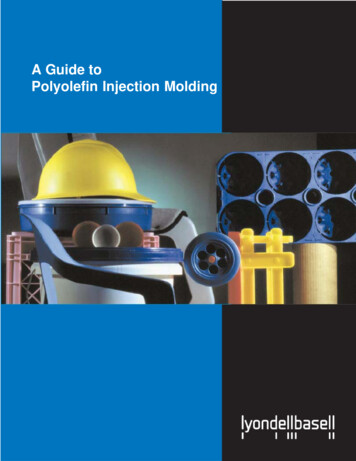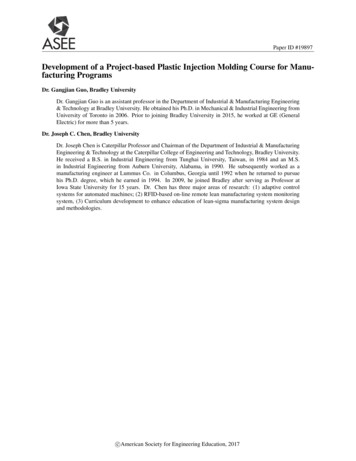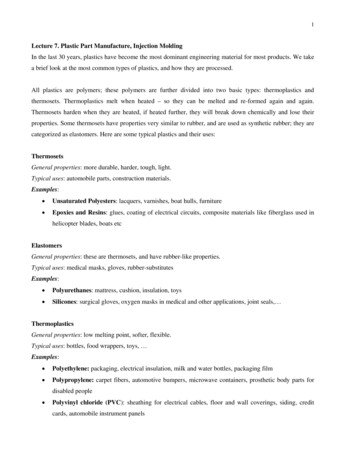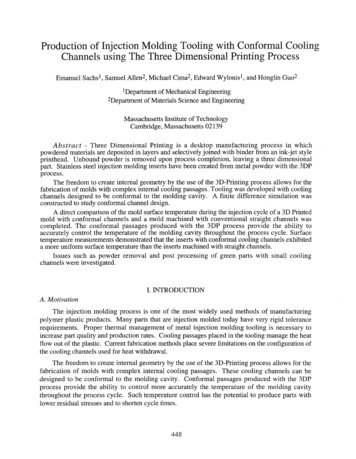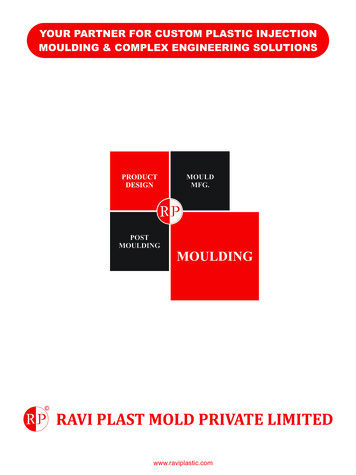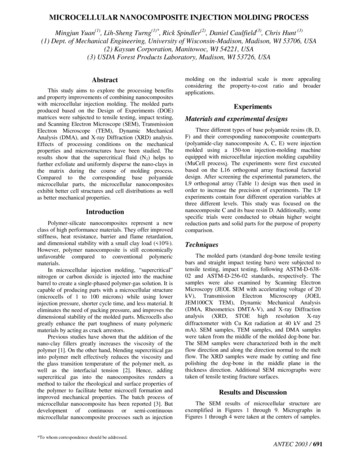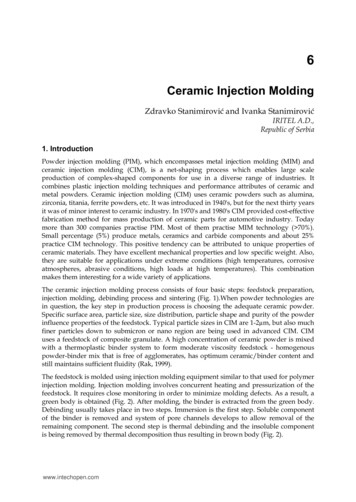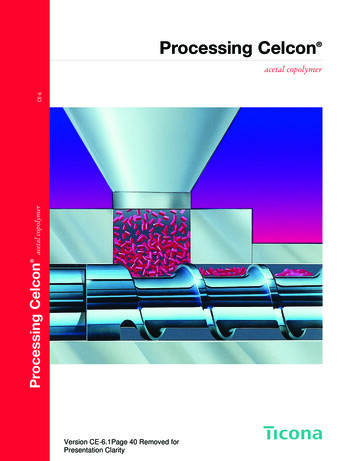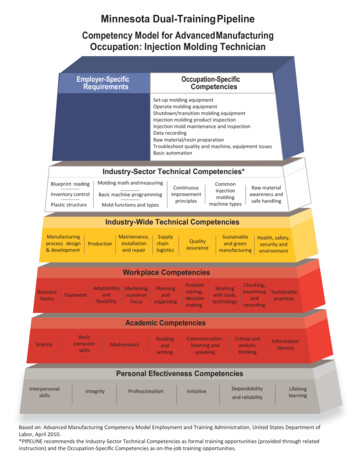
Transcription
Minnesota Dual-Training PipelineCompetency Model for Advanced ManufacturingOccupation: Injection Molding -SpecificCompetenciesSet-up molding equipmentOperate molding equipmentShutdown/transition molding equipmentInjection molding product inspectionInjection mold maintenance and inspectionData recordingRaw material/resin preparationTroubleshoot quality and machine, equipment issuesBasic automationIndustry-Sector Technical Competencies*Blueprint readingMolding math and measuringInventory controlBasic machine programmingPlastic structureMold functions and nmoldingmachine typesRaw materialawareness andsafe handlingIndustry-Wide Technical CompetenciesManufacturingprocess design& developmentProductionMaintenance,installationand bleand greenmanufacturingHealth, safety,security andenvironmentWorkplace CompetenciesBusinessbasicsTeamworkAdaptability Marketing, roblemsolving,decisionmakingWorkingwith tools,technologyChecking,examining SustainableandpracticesrecordingAcademic eadingandwritingCommunication:listening andspeakingCritical andanalyticthinkingInformationliteracyPersonal Efectiveness alismInitiativeDependabilityand reliabilityLifelonglearningBased on: Advanced Manufacturing Competency Model Employment and Training Administration, United States Department ofLabor, April 2010.*PIPELINE recommends the Industry-Sector Technical Competencies as formal training opportunities (provided through relatedinstruction) and the Occupation-Specific Competencies as on-the-job training opportunities.
Injection Molding Technician – This position is responsible for overseeing the operatingof injection molding machines to guarantee that the parts produced are up to the standardsset by the company and the customer. The Injection Molding Technician knows how to set upthe molds, troubleshoots problems in production, makes corrections, ensures quality controlsand that the product readily removes from the molds as well. Injection Molding Technicianalso knows how to ensure safe operation throughout entire set up, operation, shut down andany subsequent waste removal processes.Industry-Sector Technical Competencies Blueprint Reading – Develop the skills necessary to interpret working drawings commonto the molding field.Molding Math and Measuring – Knowledge to apply basic math skills, make accuratemeasurements and use measuring tools regarding various aspects of the moldingprocess.Inventory Control – Training in how to manage stock materials as well as track andpurchase necessary items in order to seamlessly support the overall manufacturingprocess.Mold Functions and Types – Know how molds typically allow chilled water to flow throughplastic, how to do cooling of the plastic and the extraction of the plastic part from themold. Also, have general understanding of operation of the common types of molds suchas two-plate molds, three-plate molds, cold runner terminology and runnerless molds.Common Injection Molding Machine Types – General understanding of the operation andproperties associated with using electric injection molding machines such as servo motordrive systems, ball screw drive mechanism, precision of molding machines and hydraulicpressure vs. plastic pressure-based machinery.Continuous Improvement Principles - Understands how to look for ways to minimizeand reduce process wastes, to notice and correct machine abnormalities, to maintainrecords and to adapt to process changes such as cycle times, set-ups and tooling.Raw Material Awareness and Safe Handling – General understanding of the differentraw materials possibly involved in injection molding and how certain machinesettings, temperatures, etc. can potentially impact different materials and plastics.Know how to safely remove excess materials as well as how to manage anyenvironmental concerns with material removal.Plastic structure – Understanding of the basic types of plastic structures such asthermoplastic, thermoset, copolymer and blends.Basic Machine Programming – Understand how to do basic programming andautomation functions for assembly machines.
Occupation-Specific Competencies Set-up molding equipment – Ability to select correct tools and materials, performmechanical set-up according to company standards and equipment specifications, testsand validates set-up before going to full production. Operate molding equipment - Ability to operate injection molding equipment duringproduction cycle, knowing how to monitor quality, document processes andadjustments, monitor machine settings and safely operate machinery during entireproduction cycle. Shutdown/ Transition molding equipment – Knowledgeable in how to safely andeffectively shut down injection machining to maintain tooling and lessen timenecessary to transition to new production set-up while disassembling equipment andcomponents if necessary.Injection Molding Product Inspection – Demonstrate how to identify defects, confirmproduct is up to customer molding standards, and use appropriate tools to accomplishmold inspections.Injection Mold Maintenance & Inspection – Know how to properly care for, store,operate and do routine maintenance to individual molds.Data Recording – Know how to regularly maintain records of materials used, productsmade and timing for set-up, operation cycle time and change over to new / differentproduct(s).Raw Material/ Resin Preparation – In addition to knowing the technical aspects of rawmaterial/ resin handling, it is also important to know how to properly dry and feed thematerial throughout the manufacturing process.Troubleshoot Quality and Machine/ Equipment Issues - Know how to strategicallythink through what may be causing quality defects as well as machine / equipmentissues and quickly brainstorm and implement approaches to address these concerns.Basic Automation- Understand how to operate equipment and oversee tasks that areautomated with machinery and/or robotics such as axis robotics and sprue pickers forexample.
Injection Molding Technician Occupational CompetencyTraining PlanRelated Instruction means an organized and systematic form of instruction designed to provide the dualtrainee with the knowledge of the theoretical and technical subjects related to their trade, occupation, orindustry.CourseBlueprint ReadingCourseDescriptionCredit/NonCreditHours SpentonCompetencyMolding Math andMeasurementInventory ControlMold Function and TypesContinuousImprovement PrinciplesRaw Material Awareness andSafe HandlingPlastic structureBasic Machine ProgrammingCommon Injection MoldingMachine TypesOn-The-Job Training is the work experience and instruction. Training experience need not be in theexact order as listed below.Trainer/InstructorName of person responsible Hours spentfor verifying competencyonmasterycompetencySet-up Molding EquipmentOperate Molding EquipmentShutdown/ TransitionMolding EquipmentInjection Molding ProductInspection
Injection Mold Maintenanceand InspectionData recordingRaw Material/ ResinpreparationTroubleshoot quality andmachine/ equipment issuesBasic Automation
Common Injection Molding Machine Types – General understanding of the operation and properties associated with using electric injection molding machines such as servo motor drive systems, ball screw drive mechanism, precision of molding machines and
